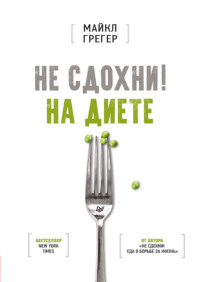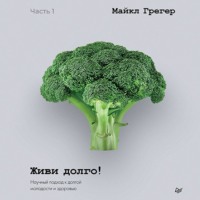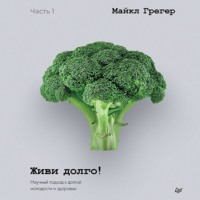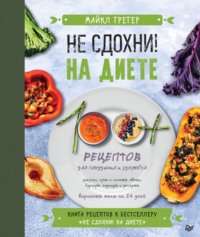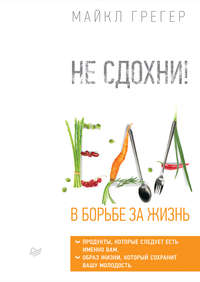
Полная версия
Живи долго! Научный подход к долгой молодости и здоровью
3747
Kapur NK, Musunuru K. Clinical efficacy and safety of statins in managing cardiovascular risk. Vasc Health Risk Manag. 2008;4(2):341–53. https://pubmed.ncbi.nlm.nih.gov/18561510/
3748
Friedman SM, Barnett CH, Franki R, Pollock B, Garver B, Barnett TD. Jumpstarting health with a 15-day whole-food plant-based program. Am J Lifestyle Med. Published online April 8, 2021:155982762110063.; https://pubmed.ncbi.nlm.nih.gov/35706593/
3749
Paz MA, de-La-Sierra A, Sáez M, et al. Treatment efficacy of anti-hypertensive drugs in monotherapy or combination: ATOM systematic review and meta-analysis of randomized clinical trials according to PRISMA statement. Medicine (Baltimore). 2016;95(30):e4071. https://pubmed.ncbi.nlm.nih.gov/27472680/
3750
Lin CL, Fang TC, Gueng MK. Vascular dilatory functions of ovo-lactovegetarians compared with omnivores. Atherosclerosis. 2001;158(1):247–51. https://pubmed.ncbi.nlm.nih.gov/11500198/
3751
Ernst E, Pietsch L, Matrai A, Eisenberg J. Blood rheology in vegetarians. Br J Nutr. 1986;56(3):555–60. https://pubmed.ncbi.nlm.nih.gov/3676231/
3752
McCarty MF. Favorable impact of a vegan diet with exercise on hemorheology: implications for control of diabetic neuropathy. Med Hypotheses. 2002;58(6):476–86. https://pubmed.ncbi.nlm.nih.gov/12323113/
3753
Dintenfass L. Effect of low-fat, low-protein diet on blood viscosity factors. Med J Aust. 1982;1(13):543. https://onlinelibrary.wiley.com/doi/abs/10.5694/j.1326–5377.1982.tb124177.x
3754
Ernst E, Franz A. Blood fluidity score during vegetarian and hypocaloric diets – a pilot study. Complement Ther Med. 1995;3(2):70–1. https://www.sciencedirect.com/science/article/abs/pii/S0965229995800026?via%3Dihub
3755
Tong TYN, Appleby PN, Bradbury KE, et al. Risks of ischaemic heart disease and stroke in meat eaters, fish eaters, and vegetarians over 18 years of follow-up: results from the prospective EPIC-Oxford study. BMJ. Published online September 4, 2019:l4897.; https://pubmed.ncbi.nlm.nih.gov/31484644/
3756
Petermann-Rocha F, Parra-Soto S, Gray S, et al. Vegetarians, fish, poultry, and meat-eaters: who has higher risk of cardiovascular disease incidence and mortality? A prospective study from UK Biobank. Eur Heart J. 2021;42(12):1136–43. https://pubmed.ncbi.nlm.nih.gov/33313747/
3757
Chiu THT, Chang HR, Wang LY, Chang CC, Lin MN, Lin CL. Vegetarian diet and incidence of total, ischemic, and hemorrhagic stroke in 2 cohorts in Taiwan. Neurology. 2020;94(11):e1112–21. https://pubmed.ncbi.nlm.nih.gov/32102976/
3758
Baden MY, Shan Z, Wang F, et al. Quality of plant-based diet and risk of total, ischemic, and hemorrhagic stroke. Neurology. 2021;96(15):e1940–53. https://pubmed.ncbi.nlm.nih.gov/33692165/
3759
Lu JW, Yu LH, Tu YK, et al. Risk of incident stroke among vegetarians compared to nonvegetarians: a systematic review and meta-analysis of prospective cohort studies. Nutrients. 2021;13(9):3019. https://pubmed.ncbi.nlm.nih.gov/34578897/
3760
Jafari S, Hezaveh E, Jalilpiran Y, et al. Plant-based diets and risk of disease mortality: a systematic review and meta-analysis of cohort studies. Crit Rev Food Sci Nutr. Published online May 6, 2021:1–13.; https://pubmed.ncbi.nlm.nih.gov/33951994/
3761
Mazidi M, Katsiki N, Mikhailidis DP, Sattar N, Banach M. Lower carbohydrate diets and all-cause and cause-specific mortality: a population-based cohort study and pooling of prospective studies. Eur Heart J. 2019;40(34):2870–9. https://pubmed.ncbi.nlm.nih.gov/31004146/
3762
Schutz Y, Montani JP, Dulloo AG. Low-carbohydrate ketogenic diets in body weight control: a recurrent plaguing issue of fad diets? Obes Rev. 2021;22 Suppl 2:e13195. https://pubmed.ncbi.nlm.nih.gov/33471427/
3763
Mazidi M, Katsiki N, Mikhailidis DP, Sattar N, Banach M. Lower carbohydrate diets and all-cause and cause-specific mortality: a population-based cohort study and pooling of prospective studies. Eur Heart J. 2019;40(34):2870–9. https://pubmed.ncbi.nlm.nih.gov/31004146/
3764
Fleming RM. The effect of high-protein diets on coronary blood flow. Angiology. 2000;51(10):817–26. https://pubmed.ncbi.nlm.nih.gov/11108325/
3765
Schwingshackl L, Hoffmann G. Low-carbohydrate diets impair flow-mediated dilatation: evidence from a systematic review and meta-analysis. Br J Nutr. 2013;110(5):969–70. https://pubmed.ncbi.nlm.nih.gov/23829973/
3766
Nicholls SJ, Lundman P, Harmer JA, et al. Consumption of saturated fat impairs the anti-inflammatory properties of high-density lipoproteins and endothelial function. J Am Coll Cardiol. 2006;48(4):715–20. https://pubmed.ncbi.nlm.nih.gov/16904539/
3767
Phillips SA, Jurva JW, Syed AQ, et al. Benefit of low-fat over low-carbohydrate diet on endothelial health in obesity. Hypertension. 2008;51(2):376–82. https://pubmed.ncbi.nlm.nih.gov/18195164/
3768
Schwingshackl L, Hoffmann G. Low-carbohydrate diets impair flow-mediated dilatation: evidence from a systematic review and meta-analysis. Br J Nutr. 2013;110(5):969–70. https://pubmed.ncbi.nlm.nih.gov/23829973/
3769
Mazidi M, Katsiki N, Mikhailidis DP, Sattar N, Banach M. Lower carbohydrate diets and all-cause and cause-specific mortality: a population-based cohort study and pooling of prospective studies. Eur Heart J. 2019;40(34):2870–9. https://pubmed.ncbi.nlm.nih.gov/31004146/
3770
Young NJ, Metcalfe C, Gunnell D, et al. A cross-sectional analysis of the association between diet and insulin-like growth factor (IGF)-I, IGF-II, IGF-binding protein (IGFBP)-2, and IGFBP-3 in men in the United Kingdom. Cancer Causes Control. 2012;23(6):907–17. https://pubmed.ncbi.nlm.nih.gov/22527168/
3771
Lee DH, Lee IK, Song K, et al. A strong dose-response relation between serum concentrations of persistent organic pollutants and diabetes: results from the National Health and Examination Survey 1999–2002. Diabetes Care. 2006;29(7):1638–44. https://pubmed.ncbi.nlm.nih.gov/16801591/
3772
Ax E, Lampa E, Lind L, et al. Circulating levels of environmental contaminants are associated with dietary patterns in older adults. Environ Int. 2015;75:93–102. https://pubmed.ncbi.nlm.nih.gov/25461418/
3773
Kris-Etherton PM, Harris WS, Appel LJ. Fish consumption, fish oil, omega-3 fatty acids, and cardiovascular disease. Arterioscler Thromb Vasc Biol. 2003;23(2):e20–30. https://pubmed.ncbi.nlm.nih.gov/12588785/
3774
Shepherd CJ, Jackson AJ. Global fishmeal and fish-oil supply: inputs, outputs and markets. J Fish Biol. 2013;83(4):1046–66. https://pubmed.ncbi.nlm.nih.gov/24090562/
3775
Abdelhamid AS, Brown TJ, Brainard JS, et al. Omega-3 fatty acids for the primary and secondary prevention of cardiovascular disease. Cochrane Database Syst Rev. 2018;7:CD003177. https://pubmed.ncbi.nlm.nih.gov/30019766/
3776
de Magalhães JP, Müller M, Rainger GEd, Steegenga W. Fish oil supplements, longevity and aging. Aging (Albany NY). 2016;8(8):1578–82. https://pubmed.ncbi.nlm.nih.gov/27564420/
3777
Bowman L, Mafham M, Wallendszus K, et al. Effects of n-3 fatty acid supplements in diabetes mellitus. N Engl J Med. 2018;379(16):1540–50. https://pubmed.ncbi.nlm.nih.gov/30146932/
3778
Kalstad AA, Myhre PL, Laake K, et al. Effects of n-3 fatty acid supplements in elderly patients after myocardial infarction: a randomized, controlled trial. Circulation. 2021;143(6):528–39. https://pubmed.ncbi.nlm.nih.gov/33191772/
3779
Nicholls SJ, Lincoff AM, Garcia M, et al. Effect of high-dose omega-3 fatty acids vs corn oil on major adverse cardiovascular events in patients at high cardiovascular risk: the STRENGTH randomized clinical trial. JAMA. 2020;324(22):2268–80. https://pubmed.ncbi.nlm.nih.gov/33190147/
3780
Manson JE, Cook NR, Lee IM, et al. Marine n-3 fatty acids and prevention of cardiovascular disease and cancer. N Engl J Med. 2019;380(1):23–32. https://pubmed.ncbi.nlm.nih.gov/30415637/
3781
Bhatt DL, Steg PG, Miller M, et al. Cardiovascular risk reduction with icosapent ethyl for hypertriglyceridemia. N Engl J Med. 2019;380(1):11–22. https://pubmed.ncbi.nlm.nih.gov/30415628/
3782
Park S, Lee S, Kim Y, et al. Causal effects of serum levels of n-3 or n-6 polyunsaturated fatty acids on coronary artery disease: Mendelian randomization study. Nutrients. 2021;13(5):1490. https://pubmed.ncbi.nlm.nih.gov/33924952/
3783
Nicholls SJ, Nelson AJ. The fish-oil paradox. Curr Opin Lipidol. 2020;31(6):356–61. https://pubmed.ncbi.nlm.nih.gov/33027227/
3784
Wennberg M, Tornevi A, Johansson I, Hörnell A, Norberg M, Bergdahl IA. Diet and lifestyle factors associated with fish consumption in men and women: a study of whether gender differences can result in gender-specific confounding. Nutr J. 2012;11:101. https://pubmed.ncbi.nlm.nih.gov/23210480/
3785
Mariotti F. Animal and plant protein sources and cardiometabolic health. Adv Nutr. 2019;10(Suppl_4):S351–66. https://pubmed.ncbi.nlm.nih.gov/31728490/
3786
Krittanawong C, Isath A, Hahn J, et al. Fish consumption and cardiovascular health: a systematic review. Am J Med. 2021;134(6):713–20. https://pubmed.ncbi.nlm.nih.gov/33444594/
3787
Gardner CD, Mehta T, Bernstein A, Aronson D. Three factors that need to be addressed more consistently in nutrition studies: “Instead of what?”, “In what context?”, and “For what?.” Am J Health Promot. 2021;35(6):881–2. https://journals.sagepub.com/doi/full/10.1177/08901171211016191d
3788
Song M, Fung TT, Hu FB, et al. Association of animal and plant protein intake with all-cause and cause-specific mortality. JAMA Intern Med. 2016;176(10):1453–63. https://pubmed.ncbi.nlm.nih.gov/27479196/
3789
Rimm EB, Appel LJ, Chiuve SE, et al. Seafood long-chain n-3 polyunsaturated fatty acids and cardiovascular disease: a science advisory from the American Heart Association. Circulation. 2018;138(1):e35–47. https://pubmed.ncbi.nlm.nih.gov/29773586/
3790
Guasch-Ferré M, Satija A, Blondin SA, et al. Meta-analysis of randomized controlled trials of red meat consumption in comparison with various comparison diets on cardiovascular risk factors. Circulation. 2019;139(15):1828–45. https://pubmed.ncbi.nlm.nih.gov/30958719/
3791
Song M, Fung TT, Hu FB, et al. Association of animal and plant protein intake with all-cause and cause-specific mortality. JAMA Intern Med. 2016;176(10):1453–63. https://pubmed.ncbi.nlm.nih.gov/27479196/
3792
Sun Y, Liu B, Snetselaar LG, et al. Association of major dietary protein sources with all-cause and cause-specific mortality: prospective cohort study. J Am Heart Assoc. 2021;10(5):e015553. https://pubmed.ncbi.nlm.nih.gov/33624505/
3793
Song M, Fung TT, Hu FB, et al. Association of animal and plant protein intake with all-cause and cause-specific mortality. JAMA Intern Med. 2016;176(10):1453–63. https://pubmed.ncbi.nlm.nih.gov/27479196/
3794
Esselstyn CB. Resolving the coronary artery disease epidemic through plant-based nutrition. Prev Cardiol. 2001;4(4):171–7. https://pubmed.ncbi.nlm.nih.gov/11832674/
3795
Affairs of the Heart. Frontier profile: Bill Castelli. Scientific American Frontiers. http://www.pbs.org/saf/1104/features/castelli3.htm. Accessed February 24, 2023.; https://www.pbs.org/saf/1104/features/castelli3.htm
3796
Keogh EV, Walsh RJ. Rate of greying of human hair. Nature. 1965;207(999):877–8. https://pubmed.ncbi.nlm.nih.gov/5885957/
3797
Seiberg M. Age-induced hair greying – the multiple effects of oxidative stress. Int J Cosmet Sci. 2013;35(6):532–8. https://pubmed.ncbi.nlm.nih.gov/24033376/
3798
Kumar AB, Shamim H, Nagaraju U. Premature graying of hair: review with updates. Int J Trichology. 2018;10(5):198–203. https://pubmed.ncbi.nlm.nih.gov/30607038/
3799
Commo S, Gaillard O, Thibaut S, Thibaut S, Bernard BA. Absence of TRP-2 in melanogenic melanocytes of human hair. Pigment Cell Res. 2004;17(5):488–97. https://pubmed.ncbi.nlm.nih.gov/15357835/
3800
Mastore M, Kohler L, Nappi AJ. Production and utilization of hydrogen peroxide associated with melanogenesis and tyrosinase-mediated oxidations of DOPA and dopamine. FEBS J. 2005;272(10):2407–15. https://pubmed.ncbi.nlm.nih.gov/15885091/
3801
Wood JM, Decker H, Hartmann H, et al. Senile hair graying: H2O2-mediated oxidative stress affects human hair color by blunting methionine sulfoxide repair. FASEB J. 2009;23(7):2065–75. https://pubmed.ncbi.nlm.nih.gov/19237503/
3802
Pandhi D, Khanna D. Premature graying of hair. Indian J Dermatol Venereol Leprol. 2013;79(5):641–53. https://pubmed.ncbi.nlm.nih.gov/23974581/
3803
Tobin DJ, Paus R. Graying: gerontobiology of the hair follicle pigmentary unit. Exp Gerontol. 2001;36(1):29–54. https://pubmed.ncbi.nlm.nih.gov/11162910/
3804
Fernandez-Flores A, Saeb-Lima M, Cassarino DS. Histopathology of aging of the hair follicle. J Cutan Pathol. 2019;46(7):508–19. https://pubmed.ncbi.nlm.nih.gov/30932205/
3805
Mahendiratta S, Sarma P, Kaur H, et al. Premature graying of hair: risk factors, co-morbid conditions, pharmacotherapy and reversal – a systematic review and meta-analysis. Dermatol Ther. 2020;33(6):e13990. https://pubmed.ncbi.nlm.nih.gov/32654282/
3806
Daulatabad D, Singal A, Grover C, Sharma SB, Chhillar N. Assessment of oxidative stress in patients with premature canities. Int J Trichology. 2015;7(3):91–4. https://pubmed.ncbi.nlm.nih.gov/26622150/
3807
Babadjouni A, Foulad DP, Hedayati B, Evron E, Mesinkovska N. The effects of smoking on hair health: a systematic review. Skin Appendage Disord. 2021;7(4):251–64. https://pubmed.ncbi.nlm.nih.gov/34307472/
3808
Kumar AB, Shamim H, Nagaraju U. Premature graying of hair: review with updates. Int J Trichology. 2018;10(5):198–203. https://pubmed.ncbi.nlm.nih.gov/30607038/
3809
Acer E, Kaya Erdogan H, Igrek A, Parlak H, Saraçoglu ZN, Bilgin M. Relationship between diet, atopy, family history, and premature hair graying. J Cosmet Dermatol. 2019;18(2):665–70. https://pubmed.ncbi.nlm.nih.gov/30556257/
3810
Addolorato G, Leggio L, Ojetti V, Capristo E, Gasbarrini G, Gasbarrini A. Effects of short-term moderate alcohol administration on oxidative stress and nutritional status in healthy males. Appetite. 2008;50(1):50–6. https://pubmed.ncbi.nlm.nih.gov/17602789/
3811
Mahendiratta S, Sarma P, Kaur H, et al. Premature graying of hair: risk factors, co-morbid conditions, pharmacotherapy and reversal – a systematic review and meta-analysis. Dermatol Ther. 2020;33(6):e13990. https://pubmed.ncbi.nlm.nih.gov/32654282/
3812
Acer E, Kaya Erdogan H, Igrek A, Parlak H, Saraçoglu ZN, Bilgin M. Relationship between diet, atopy, family history, and premature hair graying. J Cosmet Dermatol. 2019;18(2):665–70. https://pubmed.ncbi.nlm.nih.gov/30556257/
3813
Kumar AB, Shamim H, Nagaraju U. Premature graying of hair: review with updates. Int J Trichology. 2018;10(5):198–203. https://pubmed.ncbi.nlm.nih.gov/30607038/
3814
Noppakun N, Swasdikul D. Reversible hyperpigmentation of skin and nails with white hair due to vitamin B12 deficiency. Arch Dermatol. 1986;122(8):896–9. https://pubmed.ncbi.nlm.nih.gov/3740873/
3815
Kumar AB, Shamim H, Nagaraju U. Premature graying of hair: review with updates. Int J Trichology. 2018;10(5):198–203. https://pubmed.ncbi.nlm.nih.gov/30607038/
3816
Tobin DJ, Paus R. Graying: gerontobiology of the hair follicle pigmentary unit. Exp Gerontol. 2001;36(1):29–54. https://pubmed.ncbi.nlm.nih.gov/11162910/
3817
Tai SY, Hsieh HM, Huang SP, Wu MT. Hair dye use, regular exercise, and the risk and prognosis of prostate cancer: multicenter case-control and case-only studies. BMC Cancer. 2016;16:242. https://pubmed.ncbi.nlm.nih.gov/26996776/
3818
Towle KM, Grespin ME, Monnot AD. Personal use of hair dyes and risk of leukemia: a systematic literature review and meta-analysis. Cancer Med. 2017;6(10):2471–86. https://pubmed.ncbi.nlm.nih.gov/28925101/
3819
Odutola MK, Nnakelu E, Giles GG, van Leeuwen MT, Vajdic CM. Lifestyle and risk of follicular lymphoma: a systematic review and meta-analysis of observational studies. Cancer Causes Control. 2020;31(11):979–1000. https://pubmed.ncbi.nlm.nih.gov/32851495/
3820
Tai SY, Hsieh HM, Huang SP, Wu MT. Hair dye use, regular exercise, and the risk and prognosis of prostate cancer: multicenter case-control and case-only studies. BMC Cancer. 2016;16:242. https://pubmed.ncbi.nlm.nih.gov/26996776/
3821
Takkouche B, Regueira-Méndez C, Montes-Martínez A. Risk of cancer among hairdressers and related workers: a meta-analysis. Int J Epidemiol. 2009;38(6):1512–31. https://pubmed.ncbi.nlm.nih.gov/19755396/
3822
Qin L, Deng HY, Chen SJ, Wei W. A meta-analysis on the relationship between hair dye and the incidence of non-Hodgkin’s lymphoma. Med Princ Pract. 2019;28(3):222–30. https://pubmed.ncbi.nlm.nih.gov/30583293/
3823
Park AM, Khan S, Rawnsley J. Hair biology: growth and pigmentation. Facial Plast Surg Clin North Am. 2018;26(4):415–24. https://pubmed.ncbi.nlm.nih.gov/30213423/
3824
Williams R, Pawlus AD, Thornton MJ. Getting under the skin of hair aging: the impact of the hair follicle environment. Exp Dermatol. 2020;29(7):588–97. https://pubmed.ncbi.nlm.nih.gov/32358903/
3825
Sadick NS, Callender VD, Kircik LH, Kogan S. New insight into the pathophysiology of hair loss trigger a paradigm shift in the treatment approach. J Drugs Dermatol. 2017;16(11):s135–40. https://pubmed.ncbi.nlm.nih.gov/29141068/
3826
English RS Jr. A hypothetical pathogenesis model for androgenic alopecia: clarifying the dihydrotestosterone paradox and rate-limiting recovery factors. Med Hypotheses. 2018;111:73–81. https://pubmed.ncbi.nlm.nih.gov/29407002/
3827
Carmina E, Azziz R, Bergfeld W, et al. Female pattern hair loss and androgen excess: a report from the multidisciplinary Androgen Excess and PCOS committee. J Clin Endocrinol Metab. 2019;104(7):2875–91. https://pubmed.ncbi.nlm.nih.gov/30785992/
3828
Varothai S, Bergfeld WF. Androgenetic alopecia: an evidence-based treatment update. Am J Clin Dermatol. 2014;15(3):217–30. https://pubmed.ncbi.nlm.nih.gov/24848508/
3829
Grymowicz M, Rudnicka E, Podfigurna A, et al. Hormonal effects on hair follicles. Int J Mol Sci. 2020;21(15):E5342. https://pubmed.ncbi.nlm.nih.gov/32731328/
3830
Tai T, Kochhar A. Physiology and medical treatments for alopecia. Facial Plast Surg Clin North Am. 2020;28(2):149–59. https://pubmed.ncbi.nlm.nih.gov/32312501/
3831
Hibberts NA, Howell AE, Randall VA. Balding hair follicle dermal papilla cells contain higher levels of androgen receptors than those from non-balding scalp. J Endocrinol. 1998;156(1):59–65. https://pubmed.ncbi.nlm.nih.gov/9496234/
3832
Grymowicz M, Rudnicka E, Podfigurna A, et al. Hormonal effects on hair follicles. Int J Mol Sci. 2020;21(15):E5342. https://pubmed.ncbi.nlm.nih.gov/32731328/
3833
Campo D, D’Acunzo V. Doctors and baldness: a five thousand year old challenge. G Ital Dermatol Venereol. 2016;151(1):93–101. https://pubmed.ncbi.nlm.nih.gov/25387848/
3834
English RS Jr. A hypothetical pathogenesis model for androgenic alopecia: clarifying the dihydrotestosterone paradox and rate-limiting recovery factors. Med Hypotheses. 2018;111:73–81. https://pubmed.ncbi.nlm.nih.gov/29407002/
3835
Campo D, D’Acunzo V. Doctors and baldness: a five thousand year old challenge. G Ital Dermatol Venereol. 2016;151(1):93–101. https://pubmed.ncbi.nlm.nih.gov/25387848/
3836
Hamilton JB. Effect of castration in adolescent and young adult males upon further changes in the proportions of bare and hairy scalp. J Clin Endocrinol Metab. 1960;20:1309–18. https://pubmed.ncbi.nlm.nih.gov/13711016/
3837
Collins DT. Children of sorrow: a history of the mentally retarded in Kansas. Bull Hist Med. 1965;39:53–78. https://pubmed.ncbi.nlm.nih.gov/14284409/
3838
Kempton W, Kahn E. Sexuality and people with intellectual disabilities: a historical perspective. Sex Disabil. 1991;9(2):93–111. https://link.springer.com/article/10.1007/BF01101735
3839
Flood E. Notes on the castration of idiot children. Am J Psychol. 1899;10(2):296–301. https://www.jstor.org/stable/1412485?origin=crossref
3840
Lombardo PA. Preface & acknowledgments. In: Lombardo PA, ed. A Century of Eugenics in America: From the Indiana Experiment to the Human Genome Era. Indiana University Press; 2011:ix. https://worldcat.org/title/703156879
3841
Scott ES. Sterilization of mentally retarded persons: reproductive rights and family privacy. Duke Law J. 1986;1986(5):806–65. https://pubmed.ncbi.nlm.nih.gov/11658848/
3842
Wittmann E. To what extent were ideas and beliefs about eugenics held in Nazi Germany shared in Britain and the United States prior to the Second World War? Vesalius. 2004;10(1):16–9. https://pubmed.ncbi.nlm.nih.gov/15386878/
3843
Bolland MJ, Ames RW, Grey AB, et al. Does degree of baldness influence vitamin D status? Med J Aust. 2008;189(11–12):674–5. https://pubmed.ncbi.nlm.nih.gov/19061473/
3844
Trieu N, Eslick GD. Alopecia and its association with coronary heart disease and cardiovascular risk factors: a meta-analysis. Int J Cardiol. 2014;176(3):687–95. https://pubmed.ncbi.nlm.nih.gov/25150481/
3845
Sinclair RD, English DR, Giles GG. Are bald men more virile than their well thatched contemporaries? Med J Aust. 2013;199(11):811–2. https://pubmed.ncbi.nlm.nih.gov/24329675/
3846
Jin T, Wu T, Luo Z, Duan X, Deng S, Tang Y. Association between male pattern baldness and prostate disease: a meta-analysis. Urol Oncol. 2018;36(2):80.e7–15. https://pubmed.ncbi.nlm.nih.gov/29054497/







